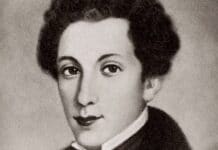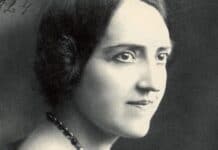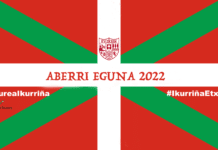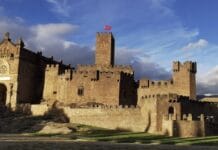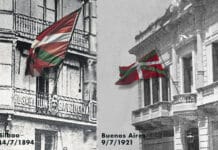“Gure aita cerue tan aicena. Sanctifica bedi sure Icena”
Era horretan laudatzen zen Jauna XVIII. Mendearen erdialdean “Biscaina/Cantabrica” hizkuntzan, Europako mapak biltzen duen arabera, kontinentean hitz egiten ziren hizkuntzekin, Synopsis Unverse Philologiae liburuan bilduta, 1730-1741* ean Nurembergen Gottfried Henselek argitaratua (Godofredus Henselius, 1687-1767), Hirschbergeko errektorea (Jelenia Góra), Lower Silesia.
Mapa bikain honi esker, euskal hizkuntzak eta euskaldunok historian zehar eragindakoa gutxitzearen saiakeran sortutako eztabaidak argitu ahal izango dira.
- Lehenengoa, agian ez garrantzitsuena baina aipatzekoa, kantabiar eta bizkaitar terminoak euskaldunaren sinónimo bezala erabiltzen zela adierazten duena da. Honi esker, historiako gaur eguneko izenak sortu izan dituzten termino batzuen erabilerari buruzko eztabaida argitu dezake (erabilera eztabaidagarria). Gaur eguneko egoera, hisotiraren erreflexu fidela balitz bezala. Honetan ikus dezakegun bezala, hori ez da horrela.
- Bigarrena, euskal hizkuntzaren pisuari buruzkoa da. Mapan ez da Gallegoa (Bai Lusitano-portugaldarra), eta ezta Bablea. Baina bai Euskara.
Guzti hau THe Afternoon Map mapa otomandiarren bloga aztertzean ezagutu dugu. Honi buruz aurreko sarreran hitz egiten dugu, “Gerratearte garaiko” euskara “sailkaezina” mapa otomandar batean. Honetan, Frank Jacobsen About Strange Maps blogari buruzko erreferentzia egiten da.
About Strange Maps – 7/1/2008 -USA
231 – Praise the Lord and Pass the Dictionary!
This delicious map is the Europa Polyglotta, published in 1730 by Gottfried Hensel (or Henselius, after the contemporary fasion of latinising surnames). I’ve managed to piece together only very little information on its origin and background because I found it on a Ukranian website, describing it in an alphabet (not to mention language) I don’t understand.
(Jarraitzen du) (Itzulpen automatikoa)
————————
The Aftermnoon Map – 1/12/2013 – USA
Ya Gokteki Babamiz
Today’s map was drawn in 1730 by someone named Gottfried Hensel, and features the opening of the Lord’s Prayer written in all the languages and scripts used throughout Europe (for more check out the entry at Strange Maps). Particularly interesting – aside from the utter incomprehensibility of the version of old english the mapmakers chose to use – is the Ottoman and Tatar renderings of the prayer. As seen below, both are written out in Arabic script using all capital letters, and the Tatar has a questionable transliteration under it. The Ottoman seems to read “Bizim Atamız ki Göktesin” and the Tatar “Ya Babimiz ki yüksek Göktesin.” It’s not clear where the mapmaker got these translations, although the language isn’t that different from several versions of the prayer in modern Turkish. Below are translations in two different registers of Turkish, one which borrows more heavily from Arabic religious terminology. Finally, Google Translate’s attempt, impressive at moments and somewhat silly at others.
(Jarraitzen du) (Itzulpen automatikoa)
Last Updated on Abe 21, 2020 by About Basque Country



